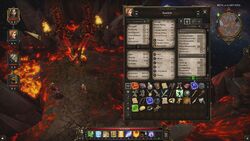RPG Codex Review: Paper Sorcerer
RPG Codex Review: Paper Sorcerer
Review - posted by Crooked Bee on Thu 20 February 2014, 15:55:27
Tags: Paper Sorcerer; UltraRunawayGames[Written by Deuce Traveler, edited by Infinitron; screenshots by Felipepepe]
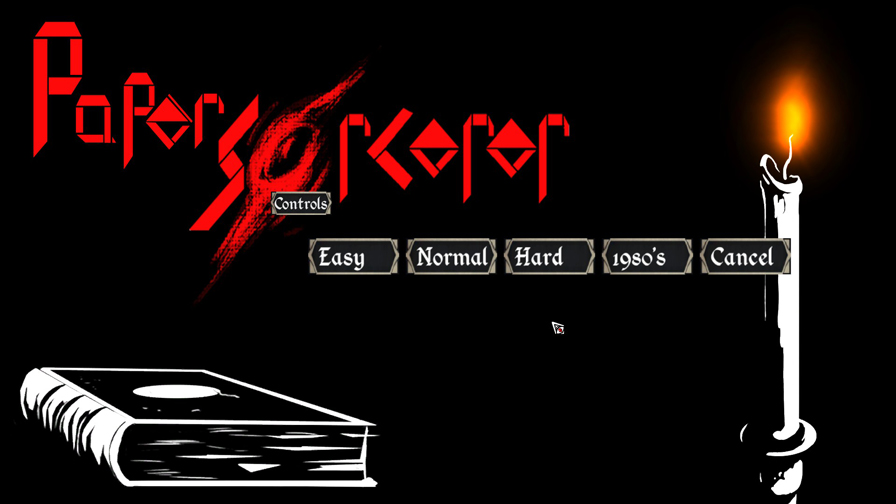
Paper Sorcerer is a first-person, party-based computer RPG that borrows heavily from Wizardry IV. You play as an evil sorcerer who was defeated by four heroes and imprisoned. You escape from your cell, summon thralls to join your party, and quest to escape from your banishment and seek revenge. For this review, I played the 2.1b PC version. This version ran solidly, and I only encountered one substantial bug in a side quest where I was able to earn a trio of powerful items multiple times.
Starting Out: First, keep in mind that there is no character creation besides choosing a gender. Your character has been stripped of all of his or her powers, but you do get to summon one monster to aid you before the first fight. The summoned monsters join your party and gain levels along with you as you progress.
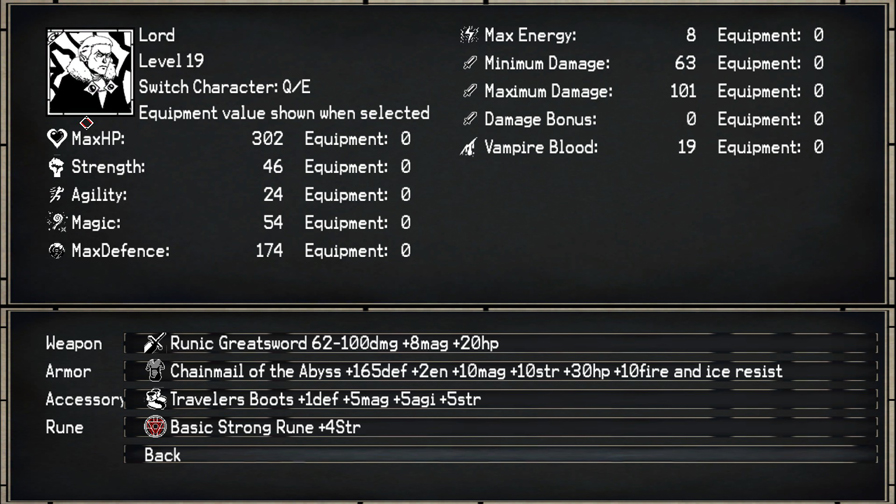
There are four different difficulty levels to choose from: Easy, Normal, Hard and "1980's". During my first trial runs, I went through the first stage of the game on Normal and on 1980's. I played on Normal with my Sorcerer, a Skeleton, a Minotaur, and a Vampire. On 1980's mode I tried my Sorcerer, a Cultist, an Abomination, and a Shadow. Eventually I settled on playing with a Vampire, Abomination and Witch on Hard mode. This party had the benefit of having two characters that could perform strong melee attacks (Abomination and Vampire), two characters capable of healing (Vampire and Witch), and two characters for arcane magic (Witch and Sorcerer). Those that want to go with a more classic party could run with a Goblin thief, Skeleton warrior, and Cultist healer. The combinations are numerous and the various classes fun to play and level up, adding to overall replayability.
You can also recruit more characters past the initial three, including a creature that you can customize with found parts called the Puppet. Although I didn't often swap my main characters for the backups I recruited, I did notice that some creatures did not have to be in the main party to be useful. For instance, the Goblin can be used to try and pick locks while in the backup roster. Dead characters can be swapped with replacements in between battles until you decide to return and have them revived.
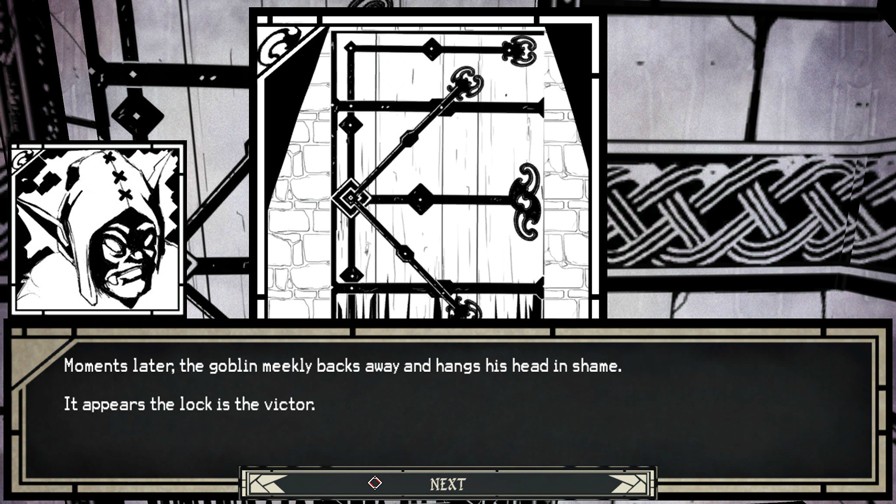
In 1980's mode, you can expect to have to reload quite often, due to deaths or using up too many resources too quickly. On the other hand, the more difficult modes also grant greater rewards when it comes to experience points and leveling up. The faster leveling doesn't really make the game much easier as you progress, but it's still quite possible to beat 1980's mode if you can survive through the first part of the game. That’s when you gain access to a bed for resting and restoring damage, and to catacombs where you can grind for levels and coin. 1980's mode does not feature any form of permadeath, so you can always reload and try again if you take a chance and the odds turn against you.
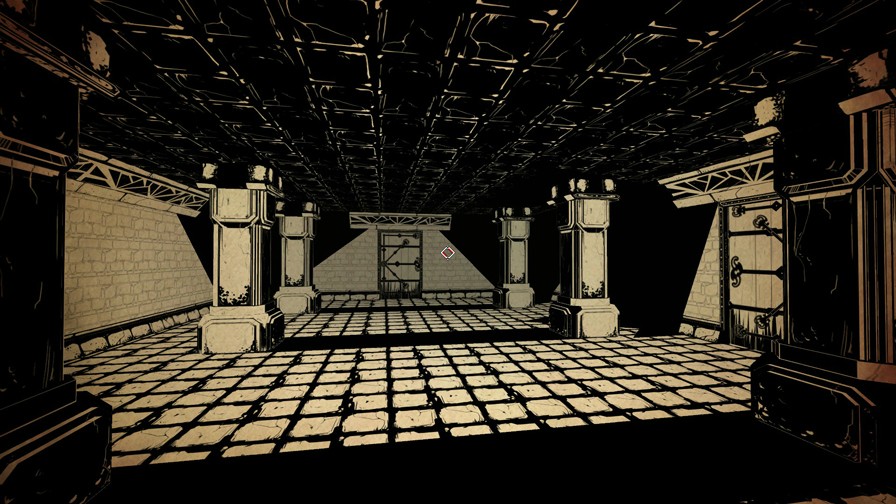
Combat: The combat system is phase-based, and should be familiar to anyone who has played a first-person party-based RPG before. You assign the actions of your characters, and once done combat unfolds in order of initiative. There is plenty of complexity, too, as each of your characters possess a wide-range of abilities with varied effectiveness dependent upon your opposition. For instance, the Abomination has special skills that do additional damage against spellcasters or neutralize their magic, while the Witch’s ability to blind and sleep enemies is quite useful against melee attackers.
Both friends and foes have Defense and Energy scores that you will need to keep track of. Energy powers your spells and special skills, and although your Energy points are limited, they will restore themselves naturally, one point per combat round. The Defense score is more unusual. Unlike Hit Points, which have to be restored by magical means or by resting, Defense points start at their maximum value at the start of each fight. Physical damage taken by a character affects the Defense score first. A high Defense often results in the struck character avoiding a loss of Hit Points altogether. However, as the Defense score is reduced, a greater amount of physical attacks leak through, causing an increasing amount of Hit Point damage. It is a neat dynamic, as you have to consider if you want to focus on using magical attacks that bypass Defense altogether, or if you want your spell slingers to help reduce an enemy’s Defense to zero in order to allow your fighters to deal their full offensive capabilities. Likewise, you’ll find yourself having to weigh the value of restoring some Defense points for your tank, or hoping his Hit Points can hold out long enough for you to turn the tide in battle.
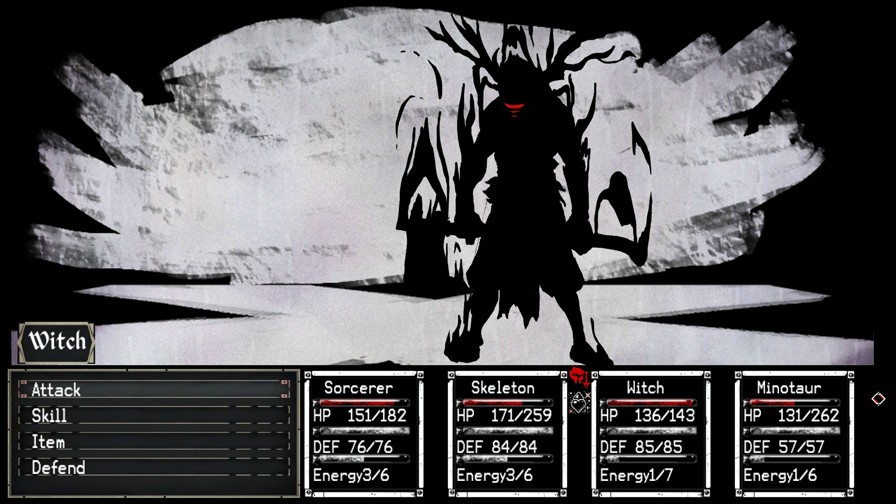
Dungeon Design: The main dungeon levels seem simplistic at first, each consisting of around a dozen or so rooms with connecting hallways. Each stage of the prison consists of three dungeon levels to explore, followed by one open area where a boss fight is conducted. It is easy to breeze through these levels, as you can always return to your home to rest up when low on health, and the enemies encountered do not respawn once defeated. However, there are hidden secrets scattered through the game that you can find if you explore thoroughly and pay attention. Finding these secrets is rewarding, as often they lead to treasure rooms with some great randomly generated loot.
Many of the stages have their own architectural style, with the graphics for the doors and walls altered to convey a different atmosphere. Some locations require you to walk across narrow causeways, while others require you to ascend or descend platforms in order to navigate them. This doesn't really make the game any more difficult, but it is a welcome attempt to break up the monotony. A couple of locations in the main dungeon also feature respawning enemies which make it difficult to map everything out, but this is thankfully used sparingly.
The catacombs are also worth exploring, as I found some of the best mid-game equipment by exploring them in between the stages of the main dungeon. There's a side quest involving the chests found at the end of each level of the catacombs, which grants you some of the best items in the game if completed. The catacombs always feature respawning enemies, which can be quite a challenge in their final levels.
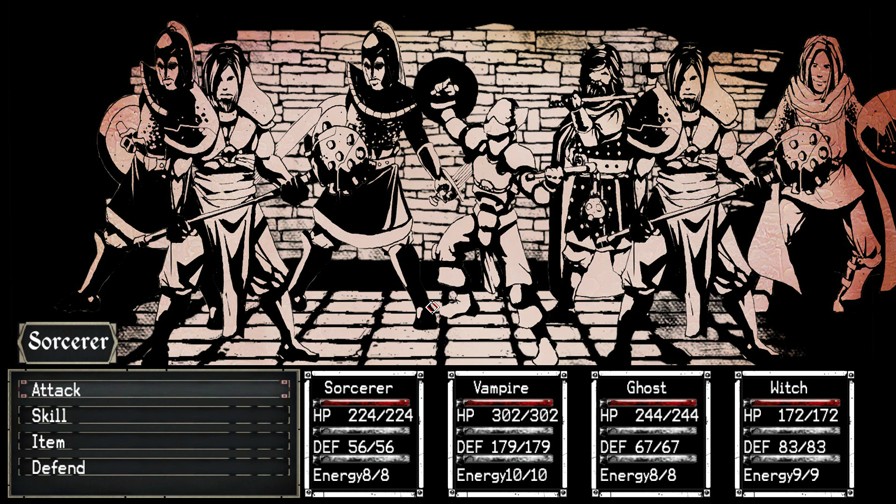
Puzzles: There are plenty of puzzles in the game, all of which can be solved with some patience and occasional backtracking. Most of these are tied to side quests, and thus aren't necessary to put effort into in order to solve the main quest. However, solving them often allows you to find 'lost souls', which can be used as barter in order to have an NPC open up more levels of the catacombs for you. Most of the puzzles are solved through finding hidden switches, though there are some that require you to use the right item in the right location. Towards the middle of the game I began to squirrel loot instead of selling it off, simply because I wasn't sure which item might be necessary later in the game. Some wrong items can be used, too, resulting in a loss of treasure for those that did not pay attention to the clues. There are also a few riddles in the game, which I had very little trouble solving, and which I thought were much easier than the riddles I remember from games back in the 80s. Some of this is most likely due to the interface. In games from the 80s you typically had to type in the exact word expected by the game. With this game's point-and-click user interface, you just click on what you believe the solution is when given a list of objects to choose from, which is obviously easier.
Choices and Consequences: This is not a game where you have choices that create significant consequences later in the game. I found that often my decisions didn't make a difference in the way the game unfolded, but only in how my character was portrayed to others. For instance, one NPC sent me on the same quest whether I wanted her help or not. However, there are some minor rewards to be gained depending on how you've interacted with the game. For example, one NPC later in the game found out that I had looted his room. When I returned the item apologetically, he thanked me. But when I decided to keep the item and be nonchalant, he rewarded me for my roguishness. I didn't notice a difference in play in regards to gender.
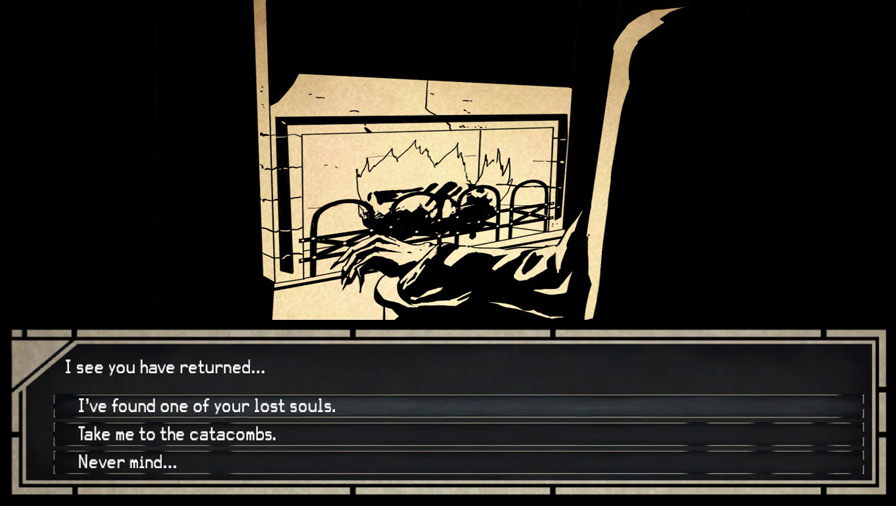
That's not to say that the in-game characters lack personality. There are quite a few NPCs that will talk to you, from the people in the center of 'town', to the heroes that speak with you before attempting to stop your progress. Journals can be found throughout the game that hint at larger interactions between various background characters, and there was even a small annotation in one book I found that discussed the economic hardships that occurred in the kingdom once you were defeated and people sought to rebuild from the ruins. These little touches help build up both lore and a sense of personality without having to resort to long animated cut scenes.
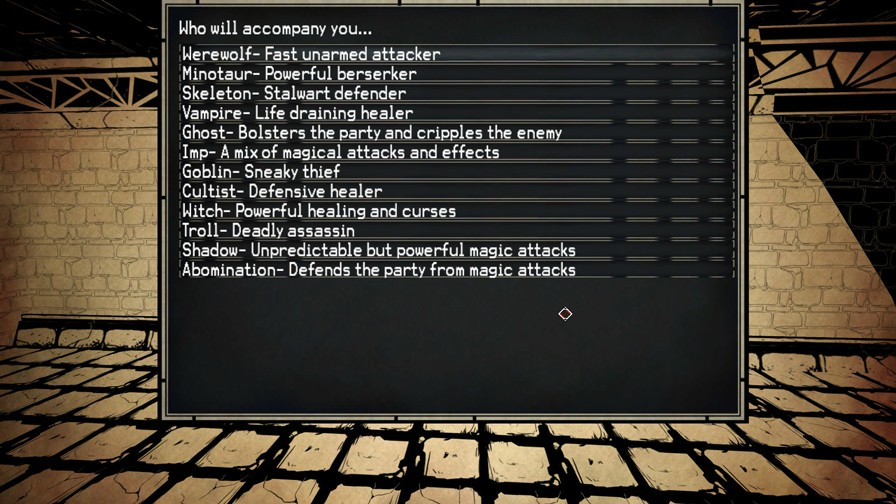
Graphics: There are very few colors used in this game, but it makes the most out of its shades of black and white. You might think that black and white sounds boring, but it's actually very impressive. The aesthetics are more than eye-catching; they are beautiful in places, especially when walking through some of the more open areas, and I have a feeling that if you added even one more color, the beauty would be lost in the transition.
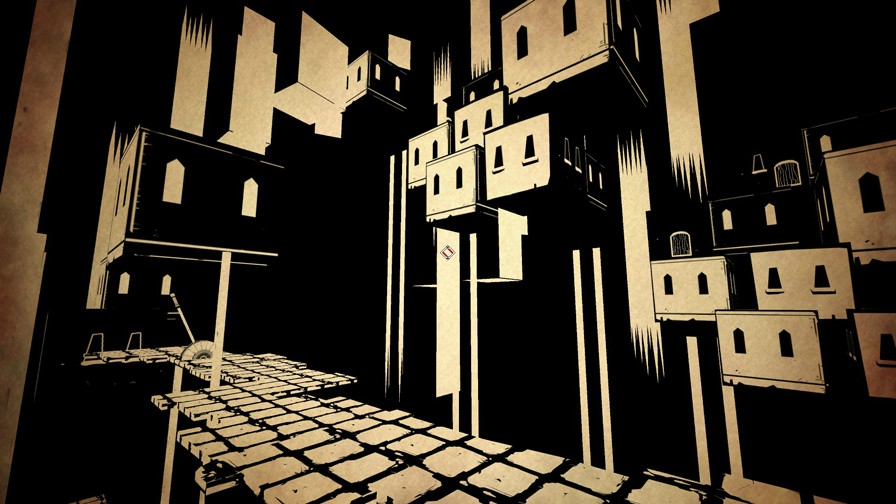
Sound: The music in the game's start menu reminded me of games from the 80s. It's a simple tune, reminiscent of old-school MIDI music. During actual gameplay the style of music changes and becomes more modern, with each zone having its own background theme. My favorite was probably the electronica beat heard in the first levels of the Catacombs, but overall I can't say that the game's music was particularly groundbreaking. Sounds in combat consist of simple swishing sounds from blows being swung, digital beeps when casting support spells, and the like.
Replayability: The replay value is what makes the game addictive. With nearly a dozen different thralls to summon, you’ll be constantly experimenting with the composition of your party to support particular play styles. I can imagine fans of the game trying to beat it with a party consisting of no tanks or no healers, for example. At the end of the game you are given an epilogue for each character you have in your party, encouraging you to play again in order to see the various endings.
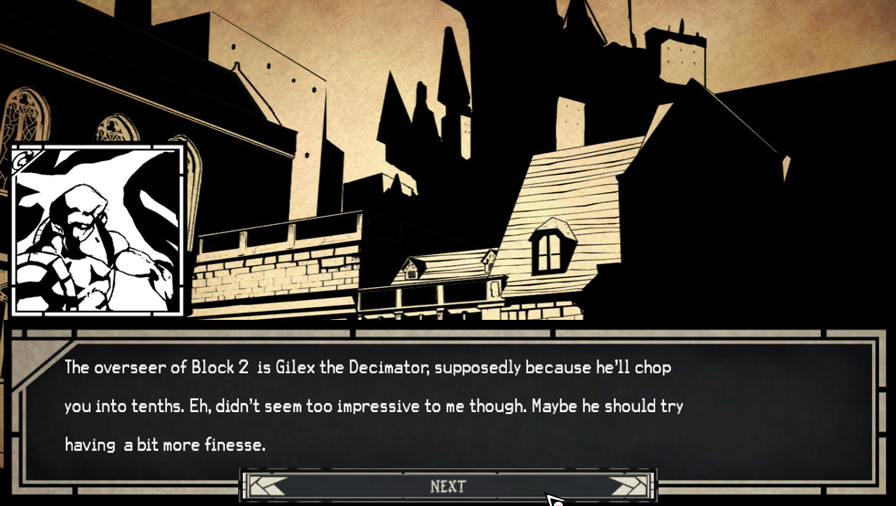
Conclusion: Although there has been very little press about it, Paper Sorcerer is a very good game. Surprisingly, it is the first title by Jesse Gallagher of Ultra Runaway Games, who had this to say about it: “Ultra Runaway Games was created when one man with no industry experience or programming training decided to make a PC RPG”. He should be very proud of what he has accomplished. Currently the game can be purchased DRM-free for $5 on his website, and is also available on Steam. Do yourself a favor and save some money by not purchasing one of the AAA games out there, and get this instead. You’ll have a much better time.

Paper Sorcerer is a first-person, party-based computer RPG that borrows heavily from Wizardry IV. You play as an evil sorcerer who was defeated by four heroes and imprisoned. You escape from your cell, summon thralls to join your party, and quest to escape from your banishment and seek revenge. For this review, I played the 2.1b PC version. This version ran solidly, and I only encountered one substantial bug in a side quest where I was able to earn a trio of powerful items multiple times.
Starting Out: First, keep in mind that there is no character creation besides choosing a gender. Your character has been stripped of all of his or her powers, but you do get to summon one monster to aid you before the first fight. The summoned monsters join your party and gain levels along with you as you progress.

There are four different difficulty levels to choose from: Easy, Normal, Hard and "1980's". During my first trial runs, I went through the first stage of the game on Normal and on 1980's. I played on Normal with my Sorcerer, a Skeleton, a Minotaur, and a Vampire. On 1980's mode I tried my Sorcerer, a Cultist, an Abomination, and a Shadow. Eventually I settled on playing with a Vampire, Abomination and Witch on Hard mode. This party had the benefit of having two characters that could perform strong melee attacks (Abomination and Vampire), two characters capable of healing (Vampire and Witch), and two characters for arcane magic (Witch and Sorcerer). Those that want to go with a more classic party could run with a Goblin thief, Skeleton warrior, and Cultist healer. The combinations are numerous and the various classes fun to play and level up, adding to overall replayability.
You can also recruit more characters past the initial three, including a creature that you can customize with found parts called the Puppet. Although I didn't often swap my main characters for the backups I recruited, I did notice that some creatures did not have to be in the main party to be useful. For instance, the Goblin can be used to try and pick locks while in the backup roster. Dead characters can be swapped with replacements in between battles until you decide to return and have them revived.

In 1980's mode, you can expect to have to reload quite often, due to deaths or using up too many resources too quickly. On the other hand, the more difficult modes also grant greater rewards when it comes to experience points and leveling up. The faster leveling doesn't really make the game much easier as you progress, but it's still quite possible to beat 1980's mode if you can survive through the first part of the game. That’s when you gain access to a bed for resting and restoring damage, and to catacombs where you can grind for levels and coin. 1980's mode does not feature any form of permadeath, so you can always reload and try again if you take a chance and the odds turn against you.

Combat: The combat system is phase-based, and should be familiar to anyone who has played a first-person party-based RPG before. You assign the actions of your characters, and once done combat unfolds in order of initiative. There is plenty of complexity, too, as each of your characters possess a wide-range of abilities with varied effectiveness dependent upon your opposition. For instance, the Abomination has special skills that do additional damage against spellcasters or neutralize their magic, while the Witch’s ability to blind and sleep enemies is quite useful against melee attackers.
Both friends and foes have Defense and Energy scores that you will need to keep track of. Energy powers your spells and special skills, and although your Energy points are limited, they will restore themselves naturally, one point per combat round. The Defense score is more unusual. Unlike Hit Points, which have to be restored by magical means or by resting, Defense points start at their maximum value at the start of each fight. Physical damage taken by a character affects the Defense score first. A high Defense often results in the struck character avoiding a loss of Hit Points altogether. However, as the Defense score is reduced, a greater amount of physical attacks leak through, causing an increasing amount of Hit Point damage. It is a neat dynamic, as you have to consider if you want to focus on using magical attacks that bypass Defense altogether, or if you want your spell slingers to help reduce an enemy’s Defense to zero in order to allow your fighters to deal their full offensive capabilities. Likewise, you’ll find yourself having to weigh the value of restoring some Defense points for your tank, or hoping his Hit Points can hold out long enough for you to turn the tide in battle.

Dungeon Design: The main dungeon levels seem simplistic at first, each consisting of around a dozen or so rooms with connecting hallways. Each stage of the prison consists of three dungeon levels to explore, followed by one open area where a boss fight is conducted. It is easy to breeze through these levels, as you can always return to your home to rest up when low on health, and the enemies encountered do not respawn once defeated. However, there are hidden secrets scattered through the game that you can find if you explore thoroughly and pay attention. Finding these secrets is rewarding, as often they lead to treasure rooms with some great randomly generated loot.
Many of the stages have their own architectural style, with the graphics for the doors and walls altered to convey a different atmosphere. Some locations require you to walk across narrow causeways, while others require you to ascend or descend platforms in order to navigate them. This doesn't really make the game any more difficult, but it is a welcome attempt to break up the monotony. A couple of locations in the main dungeon also feature respawning enemies which make it difficult to map everything out, but this is thankfully used sparingly.
The catacombs are also worth exploring, as I found some of the best mid-game equipment by exploring them in between the stages of the main dungeon. There's a side quest involving the chests found at the end of each level of the catacombs, which grants you some of the best items in the game if completed. The catacombs always feature respawning enemies, which can be quite a challenge in their final levels.

Puzzles: There are plenty of puzzles in the game, all of which can be solved with some patience and occasional backtracking. Most of these are tied to side quests, and thus aren't necessary to put effort into in order to solve the main quest. However, solving them often allows you to find 'lost souls', which can be used as barter in order to have an NPC open up more levels of the catacombs for you. Most of the puzzles are solved through finding hidden switches, though there are some that require you to use the right item in the right location. Towards the middle of the game I began to squirrel loot instead of selling it off, simply because I wasn't sure which item might be necessary later in the game. Some wrong items can be used, too, resulting in a loss of treasure for those that did not pay attention to the clues. There are also a few riddles in the game, which I had very little trouble solving, and which I thought were much easier than the riddles I remember from games back in the 80s. Some of this is most likely due to the interface. In games from the 80s you typically had to type in the exact word expected by the game. With this game's point-and-click user interface, you just click on what you believe the solution is when given a list of objects to choose from, which is obviously easier.
Choices and Consequences: This is not a game where you have choices that create significant consequences later in the game. I found that often my decisions didn't make a difference in the way the game unfolded, but only in how my character was portrayed to others. For instance, one NPC sent me on the same quest whether I wanted her help or not. However, there are some minor rewards to be gained depending on how you've interacted with the game. For example, one NPC later in the game found out that I had looted his room. When I returned the item apologetically, he thanked me. But when I decided to keep the item and be nonchalant, he rewarded me for my roguishness. I didn't notice a difference in play in regards to gender.

That's not to say that the in-game characters lack personality. There are quite a few NPCs that will talk to you, from the people in the center of 'town', to the heroes that speak with you before attempting to stop your progress. Journals can be found throughout the game that hint at larger interactions between various background characters, and there was even a small annotation in one book I found that discussed the economic hardships that occurred in the kingdom once you were defeated and people sought to rebuild from the ruins. These little touches help build up both lore and a sense of personality without having to resort to long animated cut scenes.

Graphics: There are very few colors used in this game, but it makes the most out of its shades of black and white. You might think that black and white sounds boring, but it's actually very impressive. The aesthetics are more than eye-catching; they are beautiful in places, especially when walking through some of the more open areas, and I have a feeling that if you added even one more color, the beauty would be lost in the transition.

Sound: The music in the game's start menu reminded me of games from the 80s. It's a simple tune, reminiscent of old-school MIDI music. During actual gameplay the style of music changes and becomes more modern, with each zone having its own background theme. My favorite was probably the electronica beat heard in the first levels of the Catacombs, but overall I can't say that the game's music was particularly groundbreaking. Sounds in combat consist of simple swishing sounds from blows being swung, digital beeps when casting support spells, and the like.
Replayability: The replay value is what makes the game addictive. With nearly a dozen different thralls to summon, you’ll be constantly experimenting with the composition of your party to support particular play styles. I can imagine fans of the game trying to beat it with a party consisting of no tanks or no healers, for example. At the end of the game you are given an epilogue for each character you have in your party, encouraging you to play again in order to see the various endings.

Conclusion: Although there has been very little press about it, Paper Sorcerer is a very good game. Surprisingly, it is the first title by Jesse Gallagher of Ultra Runaway Games, who had this to say about it: “Ultra Runaway Games was created when one man with no industry experience or programming training decided to make a PC RPG”. He should be very proud of what he has accomplished. Currently the game can be purchased DRM-free for $5 on his website, and is also available on Steam. Do yourself a favor and save some money by not purchasing one of the AAA games out there, and get this instead. You’ll have a much better time.











